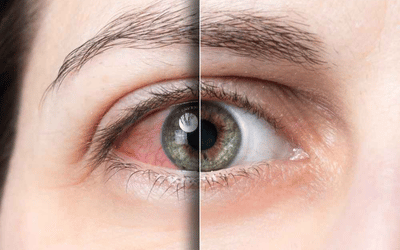Why Do Eyes Bleed?
We obtained information from Kudret Eye Istanbul’s Chief Physician, Dr. Nail Sönmez, regarding questions such as who experiences eye bleeding, its causes, and its risks:
“The eye is our window to the world. Some diseases in this sensitive and vital organ can present direct symptoms like bleeding, while others may manifest as more indirect symptoms such as headaches. Unfortunately, even when symptoms are present, they are often neglected. However, such neglect can lead to irreversible damage to the eye. Bleeding visible when looking directly at the eye is medically termed Subconjunctival hemorrhage. These hemorrhages often result from hypertension, trauma, and strain. Even everyday reflexes like sneezing or coughing can cause sub-conjunctival hemorrhages by increasing pressure. Conjunctivitis, or eye inflammation, is another significant condition that can cause eye redness. Conjunctivitis is an infection where the thin layer covering the white part of the eye becomes inflamed. Infections can be caused by bacteria, viruses, or allergies. The inflammation causes the blood vessels in the outer layer of the eye to become more visible, leading to noticeable redness. It can be easily treated with medication under the supervision of a specialist.”
What is a Posterior Eye Bleed? What Conditions Can It Indicate?
Dr. Nail Sönmez warned that posterior eye bleeding might be a sign of other diseases:
“Posterior eye bleeds, which are not visible from the outside, pose a higher risk. The primary cause of posterior eye bleeding is Diabetic Retinopathy, where diabetes affects the blood vessels in the retina, the layer of cells responsible for vision, impairing their function. Other causes include hypertension, infections behind the eye, trauma, retinal tears (retinal detachment), and age-related macular degeneration. Posterior eye bleeds can indicate other underlying health issues. Diabetes and hypertension, in particular, develop insidiously. These conditions not only threaten overall health but can also cause permanent vision loss. Therefore, routine eye examinations are crucial for maintaining eye health and identifying early signs of diseases that could threaten general health.”
Symptoms Vary from Person to Person!
Dr. Sönmez shared insights about the symptoms of posterior eye bleeding:
“The symptoms of posterior eye bleeding can vary depending on the cause. For instance, in hypertensive retinopathy, where high blood pressure causes bleeding, and in cases of trauma to the eye, there is usually pain. However, bleeding caused by other reasons may not involve pain. Sudden vision loss, decreased vision, shadowy vision, the appearance of red spots, floaters, or spider web-like images are common complaints associated with posterior eye bleeding.”
It Can Lead to Permanent Vision Loss!
Kudret Eye Istanbul’s Chief Physician, Dr. Nail Sönmez, emphasized the potential for permanent vision loss when discussing the treatment of posterior eye bleeding:
“To devise a treatment plan, it is essential to determine the cause of the bleeding. If the bleeding obstructs a clear view of the retina, ultrasound imaging is necessary. Some cases require emergency surgery, while others may need rest. In situations where the bleeding is due to a retinal tear, immediate surgical intervention is required. In cases caused by systemic diseases like diabetes, patients are put under observation and advised to rest. We ask patients under observation to rest in an upright position, use double pillows, and come for follow-ups during this period. If the bleeding does not resolve after the observation period, a vitrectomy, a surgery to clean the vitreous and remove the intraocular bleeding, is necessary. Regardless of the cause or treatment, posterior eye bleeding is a serious condition that can result in permanent vision loss. It is crucial to consult a specialist doctor without delay at the slightest complaint.”
Remember, these blog posts are for informational purposes only. If you have any medical concerns or questions, please consult a doctor.




